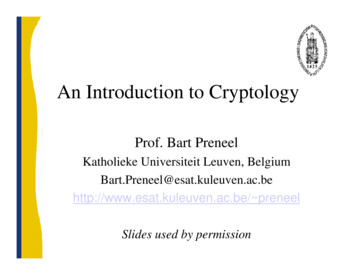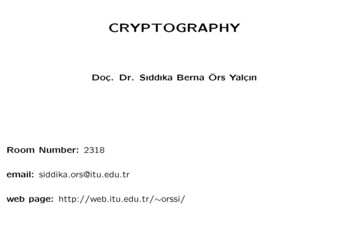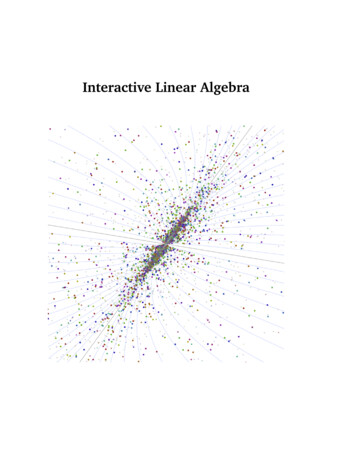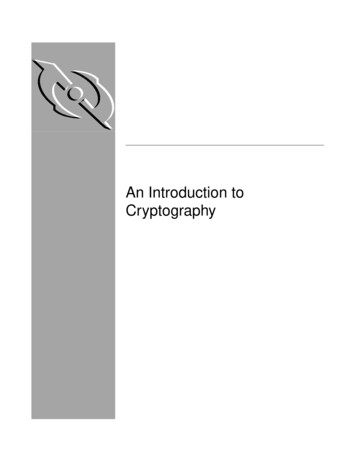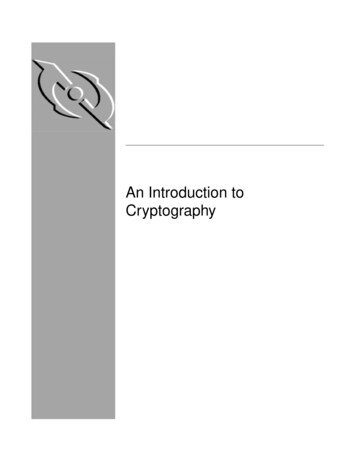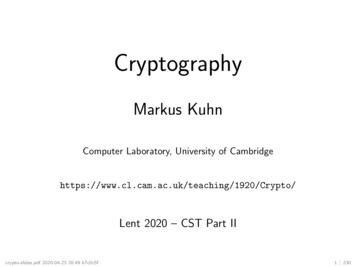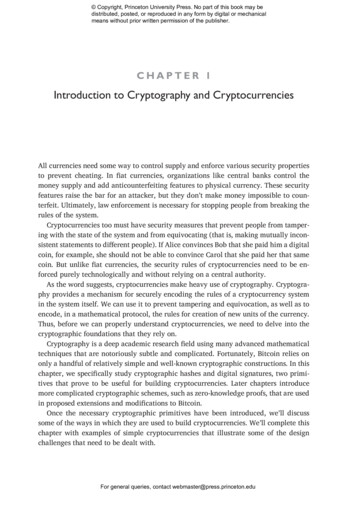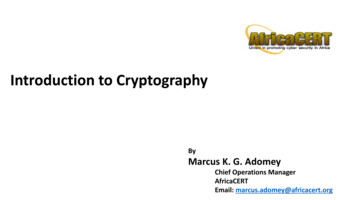
Transcription
July 2005An Introduction to Cryptography
Release InformationAn Introduction to Cryptography; released July 2005.Copyright InformationCopyright 1991–2005 by PGP Corporation. All Rights Reserved. No part of this document can bereproduced or transmitted in any form or by any means, electronic or mechanical, for any purpose,without the express written permission of PGP Corporation.Trademark InformationPGP and Pretty Good Privacy are registered trademarks, and the PGP logo is a trademark, of PGPCorporation in the U.S. and other countries. IDEA is a trademark of Ascom Tech AG. All other registered and unregistered trademarks in this document are the sole property of their respectiveowners.Licensing and Patent InformationThe IDEA cryptographic cipher described in U.S. patent number 5,214,703 is licensed from AscomTech AG. The CAST encryption algorithm is licensed from Northern Telecom, Ltd. PGP Corporationmay have patents and/or pending patent applications covering subject matter in this software or itsdocumentation; the furnishing of this software or documentation does not give you any license tothese patents.AcknowledgmentsThe compression code in PGP is by Mark Adler and Jean-Loup Gailly, used with permission fromthe free Info-ZIP implementation.Export InformationExport of this software and documentation may be subject to compliance with the rules and regulations promulgated from time to time by the Bureau of Export Administration, U.S. Department ofCommerce, which restrict the export and re-export of certain products and technical data.LimitationsThe software provided with this documentation is licensed to you for your individual use under theterms of the End User License Agreement provided with the software. The information in this document is subject to change without notice. PGP Corporation does not warrant that the informationmeets your requirements or that the information is free of errors. The information may includetechnical inaccuracies or typographical errors. Changes may be made to the information and incorporated in new editions of this document, if and when made available by PGP Corporation.About PGP CorporationRecognized worldwide as a leader in enterprise encryption technology, PGP Corporation develops,markets, and supports products used by more than 30,000 enterprises, businesses, and governments worldwide, including 90% of the Fortune 100 and 75% of the Forbes International 100.PGP products are also used by thousands of individuals and cryptography experts to secure proprietary and confidential information. During the past 14 years, PGP technology has earned a globalreputation for standards-based, trusted security products. It is the only commercial security vendorto publish source code for peer review. The unique PGP encryption product suite includes PGP Universal—an automatic, self-managing, network-based solution for enterprises—as well as desktop,mobile, FTP/batch transfer, and SDK solutions. Contact PGP Corporation at www.pgp.com or 1650 319 9000.
Table of ContentsIntroduction . . . . . . . . . . . . . . . . . . . . . . . . . . . . . . . . . . . . . . . . . . . . . . . . . . . . . 5Who should read this guide . . . . . . . . . . . . . . . . . . . . . . . . . . . . . . . . . . . . . . . . . . . . . . .5How to use this guide. . . . . . . . . . . . . . . . . . . . . . . . . . . . . . . . . . . . . . . . . . . . . . . . . . . .5Recommended readings. . . . . . . . . . . . . . . . . . . . . . . . . . . . . . . . . . . . . . . . . . . . . . . . . .6Chapter 1: The Basics of Cryptography . . . . . . . . . . . . . . . . . . . . . . . . . . . . . . . . . . 9Encryption and decryption . . . . . . . . . . . . . . . . . . . . . . . . . . . . . . . . . . . . . . . . . . . . . . . .9What is cryptography? . . . . . . . . . . . . . . . . . . . . . . . . . . . . . . . . . . . . . . . . . . . . . . . . . . .9Conventional cryptography . . . . . . . . . . . . . . . . . . . . . . . . . . . . . . . . . . . . . . . . . . . . . . .11Public-key cryptography . . . . . . . . . . . . . . . . . . . . . . . . . . . . . . . . . . . . . . . . . . . . . . . . .12How PGP cryptography works . . . . . . . . . . . . . . . . . . . . . . . . . . . . . . . . . . . . . . . . . . . .14Keys . . . . . . . . . . . . . . . . . . . . . . . . . . . . . . . . . . . . . . . . . . . . . . . . . . . . . . . . . . . . . . . .15Digital signatures . . . . . . . . . . . . . . . . . . . . . . . . . . . . . . . . . . . . . . . . . . . . . . . . . . . . . .16Digital certificates . . . . . . . . . . . . . . . . . . . . . . . . . . . . . . . . . . . . . . . . . . . . . . . . . . . . . .18Validity and trust . . . . . . . . . . . . . . . . . . . . . . . . . . . . . . . . . . . . . . . . . . . . . . . . . . . . . . .25Certificate Revocation. . . . . . . . . . . . . . . . . . . . . . . . . . . . . . . . . . . . . . . . . . . . . . . . . . .30What is a passphrase? . . . . . . . . . . . . . . . . . . . . . . . . . . . . . . . . . . . . . . . . . . . . . . . . . .31Key splitting . . . . . . . . . . . . . . . . . . . . . . . . . . . . . . . . . . . . . . . . . . . . . . . . . . . . . . . . . .32Technical details . . . . . . . . . . . . . . . . . . . . . . . . . . . . . . . . . . . . . . . . . . . . . . . . . . . . . . .32Chapter 2: The Self-Managing Security Architecture . . . . . . . . . . . . . . . . . . . . . . . . 33Introduction. . . . . . . . . . . . . . . . . . . . . . . . . . . . . . . . . . . . . . . . . . . . . . . . . . . . . . . . . . .33A Change in Thinking . . . . . . . . . . . . . . . . . . . . . . . . . . . . . . . . . . . . . . . . . . . . . . . . . . .34Self-Managing Security Architecture (SMSA) . . . . . . . . . . . . . . . . . . . . . . . . . . . . . . . . .35PGP Universal . . . . . . . . . . . . . . . . . . . . . . . . . . . . . . . . . . . . . . . . . . . . . . . . . . . . . . . . .39Chapter 3: Phil Zimmermann on PGP . . . . . . . . . . . . . . . . . . . . . . . . . . . . . . . . . . . 41Why I wrote PGP . . . . . . . . . . . . . . . . . . . . . . . . . . . . . . . . . . . . . . . . . . . . . . . . . . . . . .41The PGP symmetric algorithms . . . . . . . . . . . . . . . . . . . . . . . . . . . . . . . . . . . . . . . . . . .44How to protect public keys from tampering . . . . . . . . . . . . . . . . . . . . . . . . . . . . . . . . . .48How does PGP keep track of which keys are valid?. . . . . . . . . . . . . . . . . . . . . . . . . . . .51Table of Contentsiii
An Introduction to CryptographyHow to protect private keys from disclosure . . . . . . . . . . . . . . . . . . . . . . . . . . . . . . . . .53Beware of snake oil . . . . . . . . . . . . . . . . . . . . . . . . . . . . . . . . . . . . . . . . . . . . . . . . . . . .54Vulnerabilities . . . . . . . . . . . . . . . . . . . . . . . . . . . . . . . . . . . . . . . . . . . . . . . . . . . . . . . . .58Glossary . . . . . . . . . . . . . . . . . . . . . . . . . . . . . . . . . . . . . . . . . . . . . . . . . . . . . . . 67Index . . . . . . . . . . . . . . . . . . . . . . . . . . . . . . . . . . . . . . . . . . . . . . . . . . . . . . . . . 81ivTable of Contents
IntroductionCryptography is the stuff of spy novels and action comics. Kids once savedup Ovaltine labels and sent away for Captain Midnight’s Secret DecoderRing. Almost everyone has seen a television show or movie involving a nondescript suit-clad gentleman with a briefcase handcuffed to his wrist. Theterm “espionage” conjures images of James Bond, car chases, and flying bullets.And here you are, sitting in your office, faced with the rather mundane task ofsending a sales report to a coworker in such a way that no one else can readit. You just want to be sure that your colleague is the actual and only recipient of the email and you want him or her to know you were unmistakably thesender. It’s not national security at stake, but if your company’s competitorgot hold of it, it could cost you. How can you accomplish this?You can use cryptography. You may find it lacks some of the drama of codephrases whispered in dark alleys, but the result is the same: informationrevealed only to those for whom it was intended.Who should read this guideThis guide is useful to anyone who is interested in knowing the basics ofcryptography; it explains the terminology and technology you will encounteras you use PGP products. You will find it useful to read before you beginworking with cryptography.How to use this guideThis guide includes the following chapters: Chapter 1, “The Basics of Cryptography,” provides an overview of the terminology and concepts you will encounter as you use PGP products. Chapter 2, “The Self-Managing Security Architecture,” describes a newkind of system for secure messaging, the self-managing security architecture (SMSA). Chapter 3, “Phil Zimmermann on PGP,” written by the creator of PGP software, contains discussions of security, privacy, and the vulnerabilitiesinherent in any security system, even a system protected by PGP technology.There is also a Glossary and an Index.Introduction5
An Introduction to CryptographyRecommended readingsThis section identifies Web sites, books, and periodicals about the history,technical aspects, and politics of cryptography.The History of Cryptography The Code Book: The Evolution of Secrecy from Mary, Queen of Scots, toQuantum Cryptography, Simon Singh, Doubleday & Company, Inc., 1999,ISBN 0-385-49531-5. The Codebreakers: The Story of Secret Writing, David Kahn, Simon &Schuster Trade, 1996, ISBN 0-684-83130-9 (updated from the 1967 edition). This book is a history of codes and code breakers from the time ofthe Egyptians to the end of WWII. Kahn first wrote it in the sixties; this isthe revised edition. This book will not teach you anything about how cryptography is done, but it has been the inspiration of the whole modern generation of cryptographers. Aegean Park Press, www.aegeanparkpress.com. The Aegean Park Presspublishes a number of interesting historic books ranging from histories(such as The American Black Chamber, an exposé of U.S. cryptographyduring and after WWI) to declassified government documents.Technical Aspects of CryptographyWebsites www.iacr.org. International Association for Cryptologic Research (IACR).The IACR holds cryptographic conferences and publishes journals. www.ietf.org/rfc/rfc3156.txt. The IETF MIME Security with OpenPGPspecification, written by Michael Elkins, Dave del Torto, Raph Levien, andThomas Roessler. www.ietf.org/rfc/rfc2440.txt. The IETF OpenPGP Message Format specification, written by Jon Callas, Lutz Donnerhacke, Hal Finney, and RodneyThayer. http://en.wikipedia.org/wiki/PGP. The Wikipedia entry for PGP includes alot of good information about PGP and cryptography.Books and Periodicals 6Applied Cryptography: Protocols, Algorithms, and Source Code in C, 2ndedition, Bruce Schneier, John Wiley & Sons, 1996; ISBN 0471117099. Ifyou can only buy one book to get started in cryptography, this is the oneto buy.Introduction
An Introduction to Cryptography Handbook of Applied Cryptography, Alfred Menezes, Paul van Oorschotand Scott Vanstone, CRC Press, 1996; ISBN 0-8493-8523-7. This is thetechnical book you should get after Schneier. There is a lot of heavy-dutymath in this book, but it is nonetheless usable for those who do not understand the math. Journal of Cryptology, International Association for Cryptologic Research(IACR). See www.iacr.org. Advances in Cryptology, conference proceedings of the IACR CRYPTOconferences, published yearly by Springer-Verlag. See www.iacr.org. The Design of Rijndael: AES - The Advanced Encryption Standard, by JoanDaemen and Vincent Rijmen, published by Springer-Verlag, 2002; ISBN3540425802. The new Advanced Encryption Standard (AES) algorithm isbased on the block cipher Rijndael. The designers of Rijndael describe howit works.Politics of CryptographyWebsites www.epic.org, Electronic Privacy Information Center. www.eff.org, Electronic Frontier Foundation. www.privacy.org, privacy.org. Information resource about privacy issues. www.cdt.org, Center for Democracy and Technology. www.philzimmermann.com, Phil Zimmermann’s home page, his Senatetestimony, and more.BooksIntroduction Privacy on the Line: The Politics of Wiretapping and Encryption, WhitfieldDiffie and Susan Landau, The MIT Press, 1998, ISBN 0-262-04167-7.This book is a discussion of the history and policy surrounding cryptography and communications security. It is an excellent read, even for beginners and non-technical people. Includes information that even a lot ofexperts don’t know. Crypto: How the Code Rebels Beat the Government—Saving Privacy inthe Digital Age, Steven Levy, Penguin USA, 2001; ISBN 0140244328.7
An Introduction to CryptographyNetwork SecurityBooks8 Building Internet Firewalls, Elizabeth D. Zwicky, D. Brent Chapman, SimonCooper, and Deborah Russell (Editor), O’Reilly & Associates, Inc., 2000;ISBN: 1565928717. This book is a practical guide to designing, building,and maintaining firewalls. Firewalls and Internet Security: Repelling the Wily Hacker, William R.Cheswick, Steven M. Bellovin, Addison Wesley Longman, Inc., 1994;ISBN: 0201633574. This book is a practical guide to protecting networksfrom hacker attacks through the Internet. Network Security: Private Communication in a Public World, Second Edition, Charles Kaufman, Radia Perlman, and Mike Speciner, Pearson Education, 2002; ISBN: 0130460192. This book describes many networkprotocols, including Kerberos, IPsec, SSL, and others shows how actualsystems are constructed.Introduction
1The Basics of CryptographyWhen Julius Caesar sent messages to his generals, he didn't trust his messengers. So he replaced every A in his messages with a D, every B with an E,and so on through the alphabet. Only someone who knew the “shift by 3”rule could decipher his messages.And so we begin.Encryption and decryptionData that can be read and understood without any special measures is calledplaintext or cleartext. The method of disguising plaintext in such a way as tohide its substance is called encryption. Encrypting plaintext results in unreadable gibberish called ciphertext. You use encryption to make sure that information is hidden from anyone for whom it is not intended, even those whocan see the encrypted data. The process of reverting ciphertext to its originalplaintext is called decryption.The following figure shows this intextWhat is cryptography?Cryptography is the science of using mathematics to encrypt and decryptdata. Cryptography enables you to store sensitive information or transmit itacross insecure networks (like the Internet) so that it cannot be read by anyone except the intended recipient.While cryptography is the science of securing data, cryptanalysis is the science of analyzing and breaking secure communication. Classical cryptanalysisinvolves an interesting combination of analytical reasoning, application ofmathematical tools, pattern finding, patience, determination, and luck. Cryptanalysts are also called attackers.Cryptology embraces both cryptography and cryptanalysis.Ch. 1: The Basics of Cryptography9
An Introduction to CryptographyA related discipline is steganography, which is the science of hiding messagesrather than making them unreadable. Steganography is not cryptography; it isa form of coding. It relies on the secrecy of the mechanism used to hide themessage. If, for example, you encode a secret message by putting each letteras the first letter of the first word of every sentence, it’s secret until someoneknows to look for it, and then it provides no security at all.Strong cryptography“There are two kinds of cryptography in this world: cryptography that willstop your kid sister from reading your files, and cryptography that will stopmajor governments from reading your files. This book is about the latter.”—Bruce Schneier, Applied Cryptography: Protocols, Algorithms, and SourceCode in CPGP products are also about the latter sort of cryptography.Cryptography can be strong or weak, as explained above. Cryptographicstrength is measured in the time and resources it would require to recover theplaintext. The result of strong cryptography is ciphertext that is very difficultto decipher without possession of the appropriate decoding tool. How difficult? Given all of today’s computing power and available time—even a billioncomputers doing a billion checks a second—it is not possible to decipher theresult of strong cryptography before the end of the universe.One would think, then, that strong cryptography would hold up rather wellagainst even an extremely determined cryptanalyst. Who’s really to say? Noone has proven that the strongest encryption obtainable today will hold upunder tomorrow’s computing power. However, the strong cryptographyemployed by PGP is the best available today. Vigilance and conservatism willprotect you better, however, than claims of impenetrability.How does cryptography work?A cryptographic algorithm, or cipher, is a mathematical function used in theencryption and decryption process. A cryptographic algorithm works in combination with a key—a word, number, or phrase—to encrypt the plaintext.The same plaintext encrypts to different ciphertext with different keys. Thesecurity of encrypted data is entirely dependent on two things: the strengthof the cryptographic algorithm and the secrecy of the key.A cryptographic algorithm, plus all possible keys and all the protocols thatmake it work, comprise a cryptosystem. PGP technology is a cryptosystem.10Ch. 1: The Basics of Cryptography
An Introduction to CryptographyConventional cryptographyIn conventional cryptography, also called secret-key or symmetric-key encryption, one key is used both for encryption and decryption. The Data EncryptionStandard (DES) in an example of a conventional cryptosystem that has beenwidely deployed by the U.S. Government and the banking industry. It is beingreplaced by the Advanced Encryption Standard (AES). The following figure isan illustration of the conventional encryption intextCaesar’s cipherAn extremely simple example of conventional cryptography is a substitutioncipher. A substitution cipher substitutes one piece of information for another.This is most frequently done by offsetting letters of the alphabet. Two examples are Captain Midnight’s Secret Decoder Ring, which you may have ownedwhen you were a kid, and Julius Caesar’s cipher. In both cases, the algorithmis to offset the alphabet and the key is the number of characters to offset it.For example, if we encode the word “SECRET” using Caesar’s key value of 3,we offset the alphabet so that the 3rd letter down (D) begins the alphabet.So starting withABCDEFGHIJKLMNOPQRSTUVWXYZand sliding everything up by 3, you getDEFGHIJKLMNOPQRSTUVWXYZABCwhere D A, E B, F C, and so on.Using this scheme, the plaintext, “SECRET” encrypts as “VHFUHW.” Toallow someone else to read the ciphertext, you tell them that the key is 3.Obviously, this is exceedingly weak cryptography by today’s standards, but itworked for Caesar and it illustrates how conventional cryptography works.Ch. 1: The Basics of Cryptography11
An Introduction to CryptographyKey management and conventional encryptionConventional encryption has benefits. It is very fast. It is especially useful forencrypting data that is not going anywhere. However, conventional encryption alone as a means for transmitting secure data can be quite expensivesimply due to the difficulty of secure key distribution.Recall a character from your favorite spy movie: the person with a lockedbriefcase handcuffed to his or her wrist. What is in the briefcase, anyway?It’s probably not the secret plan itself. It’s the key that will decrypt the secretdata.For a sender and recipient to communicate securely using conventionalencryption, they must agree upon a key and keep it secret between themselves. If they are in different physical locations, they must trust a courier,the Bat Phone, or some other secure communications medium to prevent thedisclosure of the secret key during transmission.Anyone who overhears or intercepts the key in transit can later read, modify,and forge all information encrypted or authenticated with that key. From DESto Captain Midnight’s Secret Decoder Ring, the persistent problem with conventional encryption is key distribution: how do you get the key to the recipient without someone intercepting it?Public-key cryptographyThe problems of key distribution are solved by public-key cryptography, theconcept of which was introduced by Whitfield Diffie and Martin Hellman in1975. (There is now evidence that the British Secret Service invented it a fewyears before Diffie and Hellman, but kept it a military secret—and did nothingwith it.)1Public-key cryptography uses a pair of keys: a public key, which encryptsdata, and a corresponding private key, for decryption. Because it uses twokeys, it is sometimes called asymmetric cryptography. You publish your public key to the world while keeping your private key secret. Anyone with acopy of your public key can then encrypt information that only you can read,even people you have never met.112J H Ellis, The Possibility of Secure Non-Secret Digital Encryption, CESG Report, January 1970. [CESG isthe UK’s National Authority for the official use of cryptography.]Ch. 1: The Basics of Cryptography
An Introduction to CryptographyIt is computationally infeasible to deduce the private key from the public key.Anyone who has a public key can encrypt information but cannot decrypt it.Only the person who has the corresponding private key can decrypt the information.public keyprivate tThe primary benefit of public-key cryptography is that it allows people whohave no preexisting security arrangement to exchange messages securely.The need for sender and receiver to share secret keys via some secure channel is eliminated; all communications involve only public keys, and no privatekey is ever transmitted or shared. Some examples of public-key cryptosystems are Elgamal (named for its inventor, Taher Elgamal), RSA (named for itsinventors, Ron Rivest, Adi Shamir, and Leonard Adleman), Diffie-Hellman(named, you guessed it, for its inventors), and DSA, the Digital SignatureAlgorithm, (invented by David Kravitz).Because conventional cryptography was once the only available means forrelaying secret information, the expense of secure channels and key distribution relegated its use only to those who could afford it, such as governmentsand large banks (or small children with secret decoder rings). Public-keyencryption is the technological revolution that provides strong cryptographyto the adult masses. Remember the courier with the locked briefcase handcuffed to his wrist? Public-key encryption puts him out of business (probablyto his relief).Ch. 1: The Basics of Cryptography13
An Introduction to CryptographyHow PGP cryptography worksPGP combines some of the best features of both conventional and public-keycryptography. PGP is a hybrid cryptosystem.When a user encrypts plaintext with PGP, PGP first compresses the plaintext.Data compression saves modem transmission time and disk space and, moreimportantly, strengthens cryptographic security. Most cryptanalysis techniques exploit patterns found in the plaintext to crack the cipher. Compression reduces these patterns in the plaintext, thereby greatly enhancingresistance to cryptanalysis. (Files that are too short to compress or which donot compress well are not compressed.)PGP then creates a session key, which is a one-time-only secret key. This keyis a random number generated from the random movements of your mouseand the keystrokes you type. The session key works with a very secure, fastconventional encryption algorithm to encrypt the plaintext; the result isciphertext. Once the data is encrypted, the session key is then encrypted tothe recipient’s public key. This public key-encrypted session key is transmitted along with the ciphertext to the recipient.ciphertextplaintext is encryptedwith session keysession key is encryptedwith public keyciphertext encrypted session keyDecryption works in the reverse. The recipient’s copy of PGP uses his or herprivate key to recover the session key, which PGP then uses to decrypt theconventionally encrypted ciphertext.14Ch. 1: The Basics of Cryptography
An Introduction to Cryptographyencrypted messageencryptedsession keyrecipient’s private key usedto decrypt session keyciphertextsession key usedto decrypt ciphertextoriginalplaintextThe combination of the two encryption methods combines the convenience ofpublic-key encryption with the speed of conventional encryption. Conventional encryption is about 10,000 times faster than public-key encryption.Public-key encryption in turn provides a solution to key distribution and datatransmission issues. Used together, performance and key distribution areimproved without any sacrifice in security.KeysA key is a value that works with a cryptographic algorithm to produce a specific ciphertext. Keys are basically really, really, really big numbers. Key size ismeasured in bits; the number representing a 2048-bit key is darn huge. Inpublic-key cryptography, the bigger the key, the more secure the ciphertext.However, public key size and conventional cryptography’s secret key size aretotally unrelated. A conventional 80-bit key has the equivalent strength of a1024-bit public key. A conventional 128-bit key is equivalent to a 3000-bitpublic key. Again, the bigger the key, the more secure, but the algorithmsused for each type of cryptography are very different and thus comparison islike that of apples to oranges.While the public and private keys are mathematically related, it’s very difficultto derive the private key given only the public key; however, deriving the private key is always possible given enough time and computing power. Thismakes it very important to pick keys of the right size; large enough to besecure, but small enough to be applied fairly quickly. Additionally, you need toconsider who might be trying to read your files, how determined they are,how much time they have, and what their resources might be.Ch. 1: The Basics of Cryptography15
An Introduction to CryptographyLarger keys will be cryptographically secure for a longer period of time. Ifwhat you want to encrypt needs to be hidden for many years, you mightwant to use a very large key. Of course, who knows how long it will take todetermine your key using tomorrow’s faster, more efficient computers? Therewas a time when a 56-bit symmetric key was considered extremely safe.Current thinking is that 128-bit keys will be safe indefinitely, at least untilsomeone invents a usable quantum computer. We also believe that 256-bitkeys will be safe indefinitely, even if someone invents a quantum computer.This is why the AES includes options for 128 and 256-bit keys. But historytells is that it’s quite possible someone will think this statement amusinglyquaint in a few decades.Keys are stored in encrypted form. PGP software stores the keys in two fileson your hard disk; one for public keys and one for private keys. These files arecalled keyrings. As you use PGP products, you will typically add the publickeys of your recipients to your public keyring. Your private keys are stored onyour private keyring. If you lose your private keyring you will be unable todecrypt any information encrypted to keys on that ring. Consequently, it’s agood idea to keep good backups.Digital signaturesA major benefit of public key cryptography is that it provides a method foremploying digital signatures. Digital signatures let the recipient of informationverify the authenticity of the information’s origin, and also verify that theinformation was not altered while in transit. Thus, public key digital signatures provide authentication and data integrity. These features are every bitas fundamental to cryptography as privacy, if not more.A digital signature serves the same purpose as a seal on a document, or ahandwritten signature. However, because of the way it is created, it is superior to a seal or signature in an important way. A digital signature not onlyattests to the identity of the signer, but it also shows that the contents of theinformation signed has not been modified. A physical seal or handwritten signature cannot do that. However, like a physical seal that can be created byanyone with possession of the signet, a digital signature can be created byanyone with the private key of that signing keypair.Some people tend to use signatures more than they use encryption. Forexample, you may not care if anyone knows that you just deposited 1,000in your account, but you do want to be darn sure it was the bank teller youwere dealing with.16Ch. 1: The Basics of Cryptography
An Introduction to CryptographyThe basic manner in which digital signatures are created is shown in the following figure. The signature algorithm uses your private key to create the signature and the public key to verify it. If the information can be decrypted withyour public key, then it must have originated with you.private keypublic keysigningoriginal textsigned textverified textverifyingHash functionsThe system described above has some problems. It is slow, and it producesan enormous volume of data—at least double the size of the original information. An improvement on the above scheme is the addition of a one-way hashfunction in the process. A one-way hash function takes variable-lengthinput—in this case, a message of any length, even thousands or millions ofbits—and produces a fixed-length output; say, 160 bits. The hash functionensures that, if the information is changed in any way—even by just one bit—an entirely different output value is produced.PGP technology uses a c
An Introduction to Cryptography Introduction 7 Handbook of Applied Cryptography, Alfred Menezes, Paul van Oorschot and Scott Vanstone, CRC Press, 1996; ISBN -8493-8523-7. This is the technical book you should get after Schneier. There is a lot of heavy-duty math in this book, but it is nonetheless usable for those who do not under-stand .
